Abstract
Attenuated maximal activations by forskolin, Mn+. NaF or guanosine 5'-[gamma-thio]triphosphate (GTP[S]) were noted for adenylate cyclase activity in adipocytes from obese (fa/fa) Zucker rats compared with their lean (Fa/Fa) littermates. GTP[S] achieved half-maximal activation of adenylate cyclase at some 10-fold lower concentrations in membranes from lean animals compared with those from obese. Levels of the 42 and 45 kDa forms of Gs were some 40-50% lower in membranes from obese animals, and levels of Gi-1 and Gi-3 were some 62-65% lower. No differences in levels of Gi-2 alpha-subunits or G-protein beta-subunits were observed. Gi function, as assessed by inhibiting forskolin-stimulated adenylate cyclase, achieved by prostaglandin E1, nicotinate and phenylisopropyladenosine, was similar in membranes from both lean and obese animals. Levels of beta-adrenoceptors were some 50% lower in membranes from obese animals. It is suggested that the attenuated activation of adenylate cyclase by stimulatory ligands in membranes from obese animals may be caused by decreases in both Gs and receptors, and that this may contribute to the attenuated lipolytic response seen in adipocytes from such animals.
Full text
PDF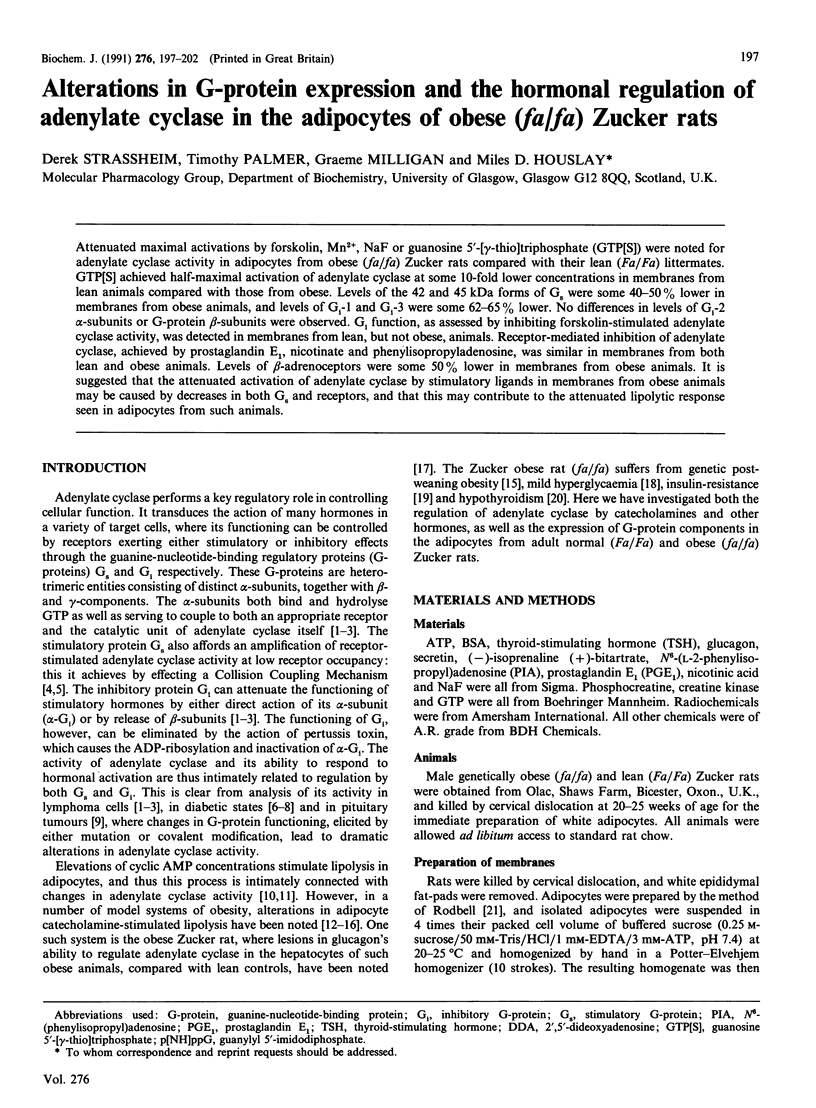
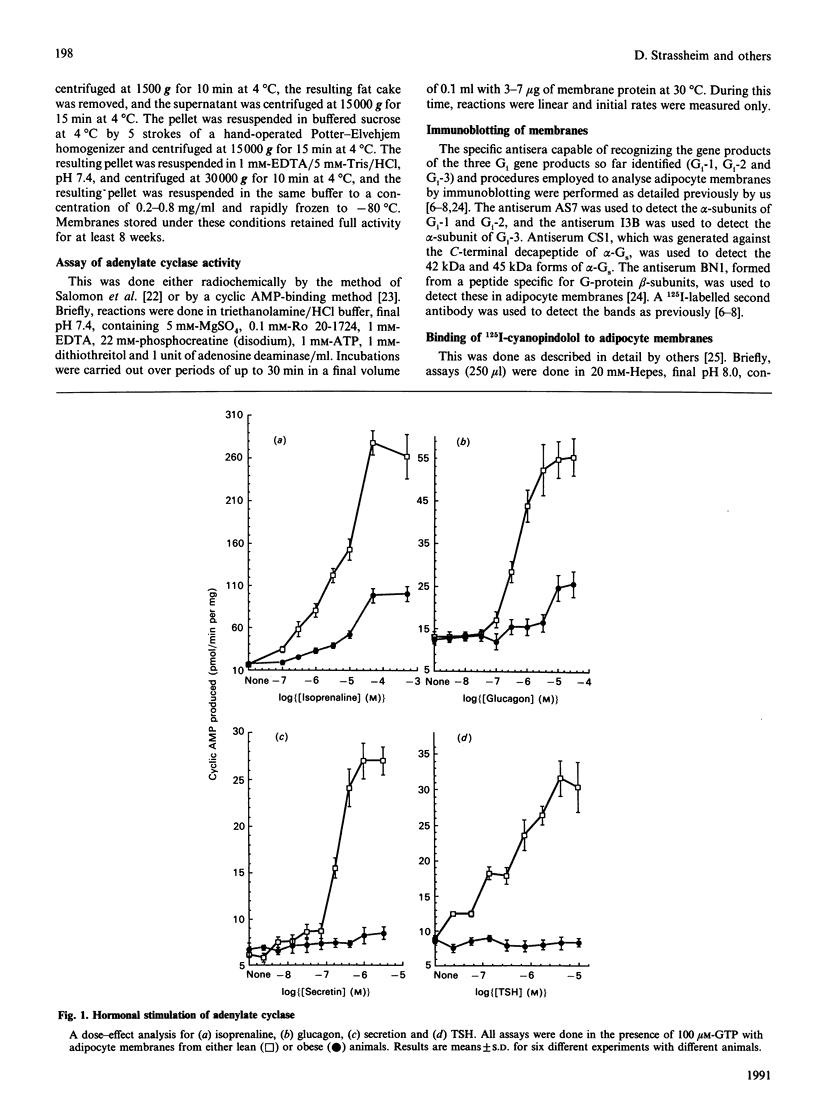
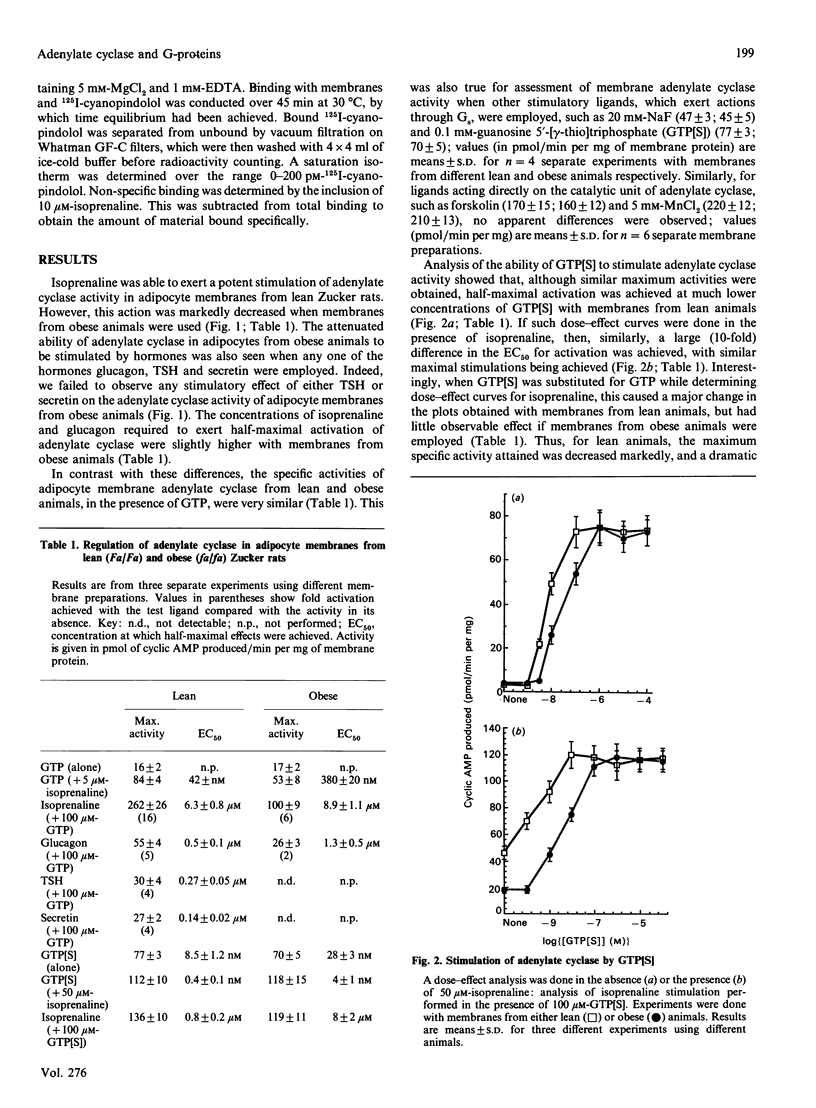
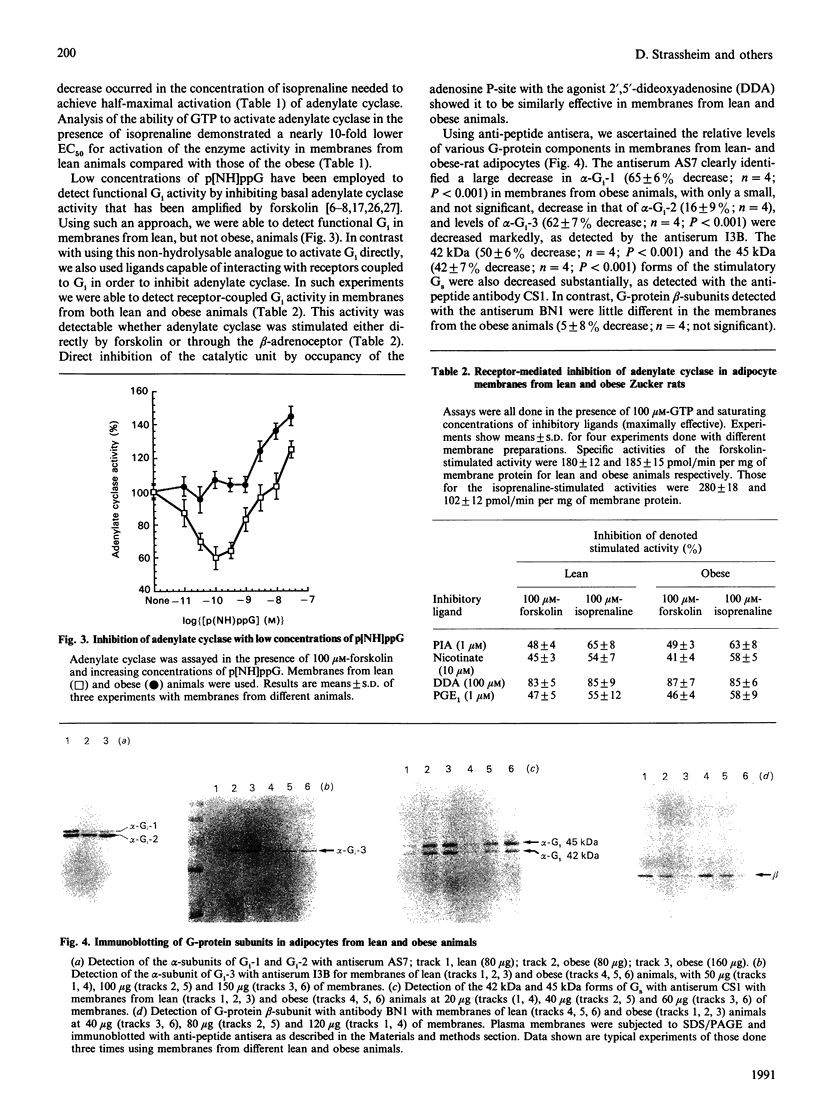
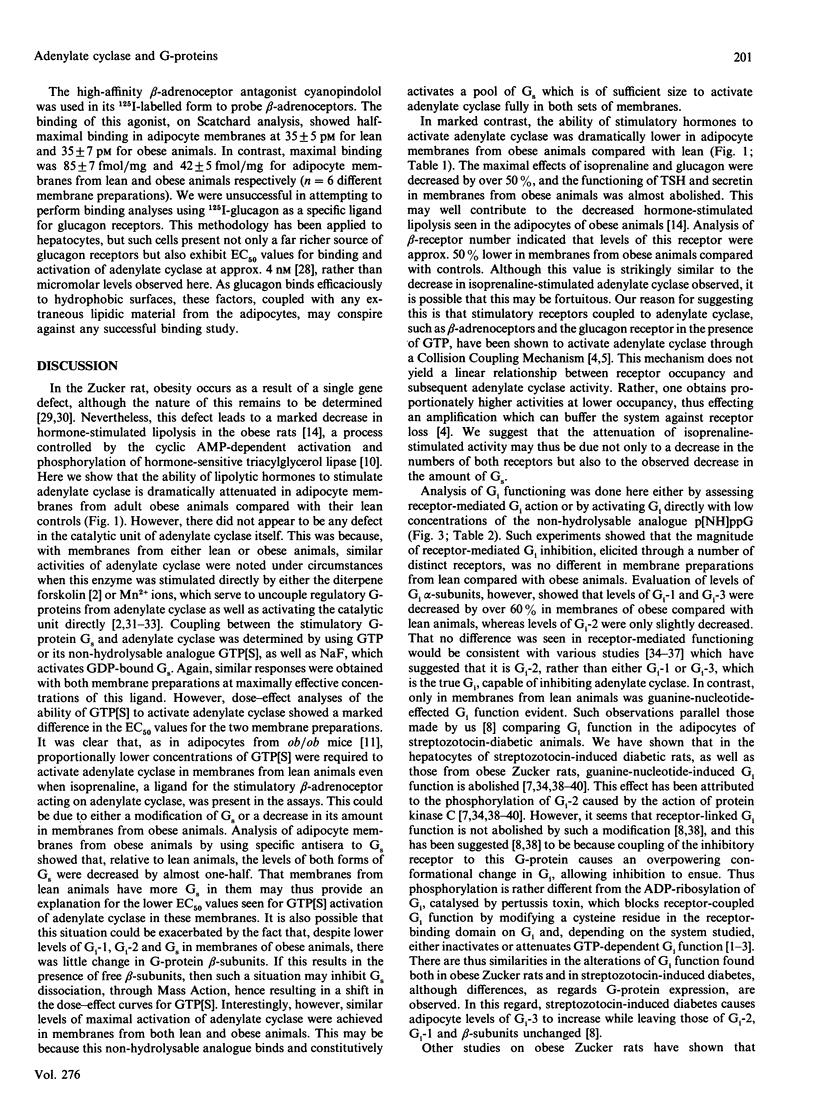
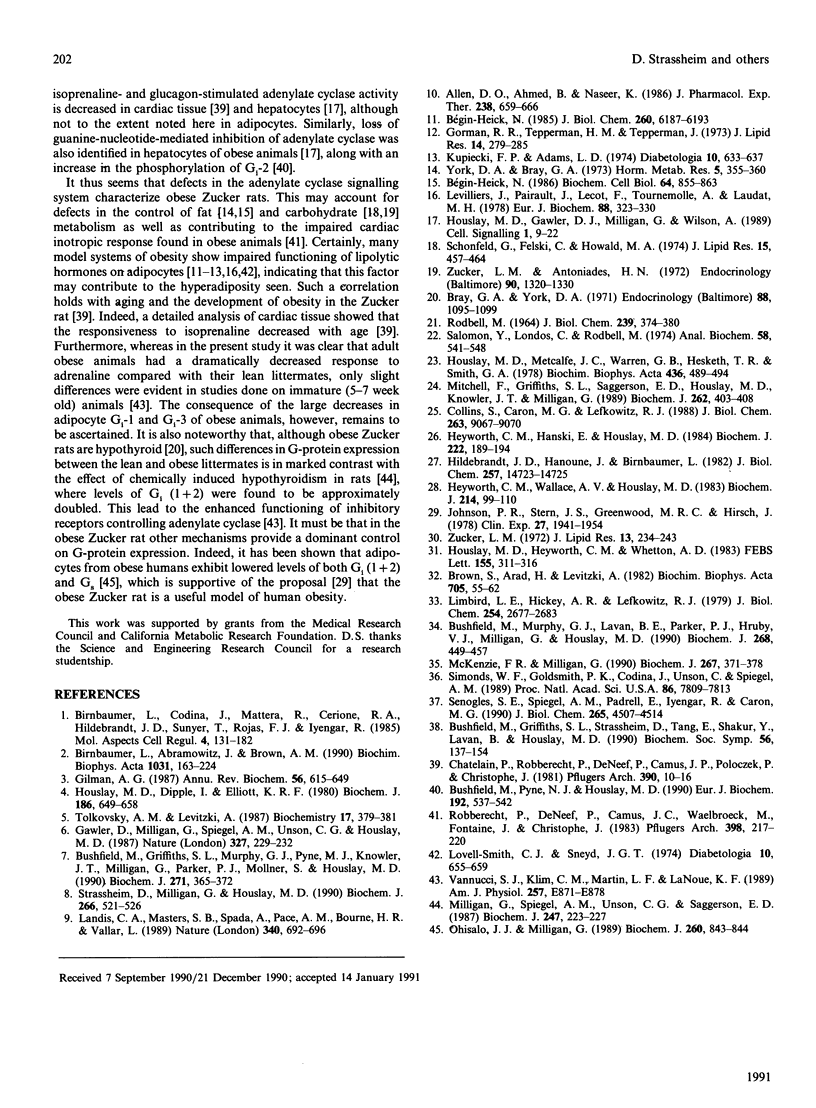
Images in this article
Selected References
These references are in PubMed. This may not be the complete list of references from this article.
- Allen D. O., Ahmed B., Naseer K. Relationships between cyclic AMP levels and lipolysis in fat cells after isoproterenol and forskolin stimulation. J Pharmacol Exp Ther. 1986 Aug;238(2):659–664. [PubMed] [Google Scholar]
- Birnbaumer L., Abramowitz J., Brown A. M. Receptor-effector coupling by G proteins. Biochim Biophys Acta. 1990 May 7;1031(2):163–224. doi: 10.1016/0304-4157(90)90007-y. [DOI] [PubMed] [Google Scholar]
- Braun S., Arad H., Levitzki A. The interaction of Mn2+ with turkey erythrocyte adenylate cyclase. Biochim Biophys Acta. 1982 Jul 12;705(1):55–62. doi: 10.1016/0167-4838(82)90335-1. [DOI] [PubMed] [Google Scholar]
- Bray G. A., York D. A. Thyroid function of genetically obese rats. Endocrinology. 1971 Apr;88(4):1095–1099. doi: 10.1210/endo-88-4-1095. [DOI] [PubMed] [Google Scholar]
- Bushfield M., Griffiths S. L., Murphy G. J., Pyne N. J., Knowler J. T., Milligan G., Parker P. J., Mollner S., Houslay M. D. Diabetes-induced alterations in the expression, functioning and phosphorylation state of the inhibitory guanine nucleotide regulatory protein Gi-2 in hepatocytes. Biochem J. 1990 Oct 15;271(2):365–372. doi: 10.1042/bj2710365. [DOI] [PMC free article] [PubMed] [Google Scholar]
- Bushfield M., Griffiths S. L., Strassheim D., Tang E., Shakur Y., Lavan B., Houslay M. D. Guanine-nucleotide-binding proteins in diabetes and insulin-resistant states. Biochem Soc Symp. 1990;56:137–154. [PubMed] [Google Scholar]
- Bushfield M., Murphy G. J., Lavan B. E., Parker P. J., Hruby V. J., Milligan G., Houslay M. D. Hormonal regulation of Gi2 alpha-subunit phosphorylation in intact hepatocytes. Biochem J. 1990 Jun 1;268(2):449–457. doi: 10.1042/bj2680449. [DOI] [PMC free article] [PubMed] [Google Scholar]
- Bushfield M., Pyne N. J., Houslay M. D. Changes in the phosphorylation state of the inhibitory guanine-nucleotide-binding protein Gi-2 in hepatocytes from lean (Fa/Fa) and obese (fa/fa) Zucker rats. Eur J Biochem. 1990 Sep 11;192(2):537–542. doi: 10.1111/j.1432-1033.1990.tb19258.x. [DOI] [PubMed] [Google Scholar]
- Bégin-Heick N. Absence of the inhibitory effect of guanine nucleotides on adenylate cyclase activity in white adipocyte membranes of the ob/ob mouse. Effect of the ob gene. J Biol Chem. 1985 May 25;260(10):6187–6193. [PubMed] [Google Scholar]
- Bégin-Heick N. The hysteretic effect of Gpp(NH)p on adenylate cyclase is not altered by Mg2+ in adipocyte membranes of ob/ob mice. Biochem Cell Biol. 1986 Sep;64(9):855–863. doi: 10.1139/o86-114. [DOI] [PubMed] [Google Scholar]
- Chatelain P., Robberecht P., De Neef P., Camus J. C., Poloczek P., Christophe J. Impairment of hormone-stimulated cardiac adenylate cyclase activity in the genetically obese (fa/fa) Zucker rat. Pflugers Arch. 1981 Apr;390(1):10–16. doi: 10.1007/BF00582704. [DOI] [PubMed] [Google Scholar]
- Collins S., Caron M. G., Lefkowitz R. J. Beta-adrenergic receptors in hamster smooth muscle cells are transcriptionally regulated by glucocorticoids. J Biol Chem. 1988 Jul 5;263(19):9067–9070. [PubMed] [Google Scholar]
- Gawler D., Milligan G., Spiegel A. M., Unson C. G., Houslay M. D. Abolition of the expression of inhibitory guanine nucleotide regulatory protein Gi activity in diabetes. Nature. 1987 May 21;327(6119):229–232. doi: 10.1038/327229a0. [DOI] [PubMed] [Google Scholar]
- Gilman A. G. G proteins: transducers of receptor-generated signals. Annu Rev Biochem. 1987;56:615–649. doi: 10.1146/annurev.bi.56.070187.003151. [DOI] [PubMed] [Google Scholar]
- Gorman R. R., Tepperman H. M., Tepperman J. Epinephrine binding and the selective restoration of adenylate cyclase activity in fat-fed rats. J Lipid Res. 1973 May;14(3):279–285. [PubMed] [Google Scholar]
- Heyworth C. M., Hanski E., Houslay M. D. Islet-activating protein blocks glucagon desensitization in intact hepatocytes. Biochem J. 1984 Aug 15;222(1):189–194. doi: 10.1042/bj2220189. [DOI] [PMC free article] [PubMed] [Google Scholar]
- Heyworth C. M., Wallace A. V., Houslay M. D. Insulin and glucagon regulate the activation of two distinct membrane-bound cyclic AMP phosphodiesterases in hepatocytes. Biochem J. 1983 Jul 15;214(1):99–110. doi: 10.1042/bj2140099. [DOI] [PMC free article] [PubMed] [Google Scholar]
- Hildebrandt J. D., Hanoune J., Birnbaumer L. Guanine nucleotide inhibition of cyc- S49 mouse lymphoma cell membrane adenylyl cyclase. J Biol Chem. 1982 Dec 25;257(24):14723–14725. [PubMed] [Google Scholar]
- Houslay M. D., Dipple I., Elliott K. R. Guanosine 5'-triphosphate and guanosine 5'-[beta gamma-imido]triphosphate effect a collision coupling mechanism between the glucagon receptor and catalytic unit of adenylate cyclase. Biochem J. 1980 Mar 15;186(3):649–658. doi: 10.1042/bj1860649. [DOI] [PMC free article] [PubMed] [Google Scholar]
- Houslay M. D., Gawler D. J., Milligan G., Wilson A. Multiple defects occur in the guanine nucleotide regulatory protein system in liver plasma membranes of obese (fa/fa) but not lean (Fa/Fa) Zucker rats: loss of functional Gi and abnormal Gs function. Cell Signal. 1989;1(1):9–22. doi: 10.1016/0898-6568(89)90016-8. [DOI] [PubMed] [Google Scholar]
- Houslay M. D., Heyworth C. M., Whetton A. D. Mechanism of glucagon activation of adenylate cyclase in the presence of Mn2+. FEBS Lett. 1983 May 8;155(2):311–316. doi: 10.1016/0014-5793(82)80627-3. [DOI] [PubMed] [Google Scholar]
- Houslay M. D., Metcalfe J. C., Warren G. B., Hesketh T. R., Smith G. A. The glucagon receptor of rat liver plasma membrane can couple to adenylate cyclase without activating it. Biochim Biophys Acta. 1976 Jun 17;436(2):489–494. doi: 10.1016/0005-2736(76)90210-8. [DOI] [PubMed] [Google Scholar]
- Johnson P. R., Stern J. S., Greenwood M. R., Hirsch J. Adipose tissue hyperplasia and hyperinsulinemia on Zucker obese female rats: a developmental study. Metabolism. 1978 Dec;27(12 Suppl 2):1941–1954. doi: 10.1016/s0026-0495(78)80011-0. [DOI] [PubMed] [Google Scholar]
- Kupiecki F. P., Adams L. D. The lipolytic system in adipose tissue of Toronto-KK and C57BL/KsJ diabetic mice. Adenylate cyclase, phosphodiesterase and protein kinase activities. Diabetologia. 1974 Nov;10 (Suppl):633–637. doi: 10.1007/BF01221997. [DOI] [PubMed] [Google Scholar]
- Landis C. A., Masters S. B., Spada A., Pace A. M., Bourne H. R., Vallar L. GTPase inhibiting mutations activate the alpha chain of Gs and stimulate adenylyl cyclase in human pituitary tumours. Nature. 1989 Aug 31;340(6236):692–696. doi: 10.1038/340692a0. [DOI] [PubMed] [Google Scholar]
- Levilliers J., Pairault J., Lecot F., Tournemolle A., Laudat M. H. Adenosine 3':5'-monophosphate and guanosine 3':5'-monophosphate: levels and cyclase activities in liver and adipose tissue from diabetic mice (db/db). Eur J Biochem. 1978 Aug 1;88(2):323–330. doi: 10.1111/j.1432-1033.1978.tb12453.x. [DOI] [PubMed] [Google Scholar]
- Limbird L. E., Hickey A. R., Lefkowitz R. J. Unique uncoupling of the frog erythrocyte adenylate cyclase system by manganese. Loss of hormone and guanine nucleotide-sensitive enzyme activities without loss of nucleotide-sensitive, high affinity agonist binding. J Biol Chem. 1979 Apr 25;254(8):2677–2683. [PubMed] [Google Scholar]
- Lovell-Smith C. J., Sneyd J. G. Lipolysis and adenosine 3'5'-cyclic monophosphate in adipose tissue of the New Zealand obese mouse; the activities of adipose tissue adenyl cyclase and phosphodiesterase. Diabetologia. 1974 Nov;10 (Suppl):655–659. doi: 10.1007/BF01222000. [DOI] [PubMed] [Google Scholar]
- Milligan G., Spiegel A. M., Unson C. G., Saggerson E. D. Chemically induced hypothyroidism produces elevated amounts of the alpha subunit of the inhibitory guanine nucleotide binding protein (Gi) and the beta subunit common to all G-proteins. Biochem J. 1987 Oct 1;247(1):223–227. doi: 10.1042/bj2470223. [DOI] [PMC free article] [PubMed] [Google Scholar]
- Mitchell F. M., Griffiths S. L., Saggerson E. D., Houslay M. D., Knowler J. T., Milligan G. Guanine-nucleotide-binding proteins expressed in rat white adipose tissue. Identification of both mRNAs and proteins corresponding to Gi1, Gi2 and Gi3. Biochem J. 1989 Sep 1;262(2):403–408. doi: 10.1042/bj2620403. [DOI] [PMC free article] [PubMed] [Google Scholar]
- Ohisalo J. J., Milligan G. Guanine-nucleotide-binding proteins Gi and Gs in fat-cells from normal, hypothyroid and obese human subjects. Biochem J. 1989 Jun 15;260(3):843–847. doi: 10.1042/bj2600843. [DOI] [PMC free article] [PubMed] [Google Scholar]
- RODBELL M. METABOLISM OF ISOLATED FAT CELLS. I. EFFECTS OF HORMONES ON GLUCOSE METABOLISM AND LIPOLYSIS. J Biol Chem. 1964 Feb;239:375–380. [PubMed] [Google Scholar]
- Robberecht P., De Neef P., Camus J. C., Waelbroeck M., Fontaine J., Christophe J. The cardiac inotropic response to secretin is lower in genetically obese (fa/fa) than in lean (fa/?) Zucker rats. Pflugers Arch. 1983 Aug;398(3):217–220. doi: 10.1007/BF00657154. [DOI] [PubMed] [Google Scholar]
- Salomon Y., Londos C., Rodbell M. A highly sensitive adenylate cyclase assay. Anal Biochem. 1974 Apr;58(2):541–548. doi: 10.1016/0003-2697(74)90222-x. [DOI] [PubMed] [Google Scholar]
- Schonfeld G., Felski C., Howald M. A. Characterization of the plasma lipoproteins of the genetically obese hyperlipoproteinemic Zucker fatty rat. J Lipid Res. 1974 Sep;15(5):457–464. [PubMed] [Google Scholar]
- Senogles S. E., Spiegel A. M., Padrell E., Iyengar R., Caron M. G. Specificity of receptor-G protein interactions. Discrimination of Gi subtypes by the D2 dopamine receptor in a reconstituted system. J Biol Chem. 1990 Mar 15;265(8):4507–4514. [PubMed] [Google Scholar]
- Simonds W. F., Goldsmith P. K., Codina J., Unson C. G., Spiegel A. M. Gi2 mediates alpha 2-adrenergic inhibition of adenylyl cyclase in platelet membranes: in situ identification with G alpha C-terminal antibodies. Proc Natl Acad Sci U S A. 1989 Oct;86(20):7809–7813. doi: 10.1073/pnas.86.20.7809. [DOI] [PMC free article] [PubMed] [Google Scholar]
- Strassheim D., Milligan G., Houslay M. D. Diabetes abolishes the GTP-dependent, but not the receptor-dependent inhibitory function of the inhibitory guanine-nucleotide-binding regulatory protein (Gi) on adipocyte adenylate cyclase activity. Biochem J. 1990 Mar 1;266(2):521–526. doi: 10.1042/bj2660521. [DOI] [PMC free article] [PubMed] [Google Scholar]
- Vannucci S. J., Klim C. M., Martin L. F., LaNoue K. F. A1-adenosine receptor-mediated inhibition of adipocyte adenylate cyclase and lipolysis in Zucker rats. Am J Physiol. 1989 Dec;257(6 Pt 1):E871–E878. doi: 10.1152/ajpendo.1989.257.6.E871. [DOI] [PubMed] [Google Scholar]
- York D. A., Bray G. A. Adipose tissue metabolism in six week old fatty rats. Horm Metab Res. 1973 Sep;5(5):355–360. doi: 10.1055/s-0028-1093923. [DOI] [PubMed] [Google Scholar]
- Zucker L. M., Antoniades H. N. Insulin and obesity in the Zucker genetically obese rat "fatty". Endocrinology. 1972 May;90(5):1320–1330. doi: 10.1210/endo-90-5-1320. [DOI] [PubMed] [Google Scholar]
- Zucker L. M. Fat mobilization in vitro and in vivo in the genetically obese Zucker rat "fatty". J Lipid Res. 1972 Mar;13(2):234–243. [PubMed] [Google Scholar]



